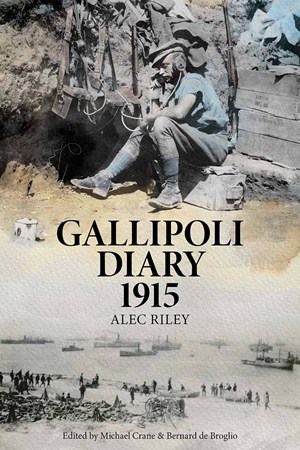GALLIPOLI DIARY 1915
Gallipoli Diary 1915
Author: Alec Riley (Edited by Michael Crane & Bernard de Broglio)
Publisher: Little Gully Press (2021), 360 pages, 47 photographs, 14 maps
Price: £13.99 (paperback) Also available in hardback and kindle
ISBN: 9780645235913
Publishers blurb … Alec Riley, a signaller with the British Army’s 42nd Division, reached Cape Helles on 6 May 1915. ‘We landed,’ he wrote, ‘in an enemy’s country, without his permission, and the event was entirely without romance.’
Riley had the rare opportunity to move freely about the Allied lines, being attached to different battalions during his four months on the Gallipoli peninsula. He kept a diary and made detailed notes, adding to them ‘while recollections were vivid, and while small details, colours, shapes, could be visualised accurately’.
After the war, Riley returned twice to the peninsula in pilgrimage, traversing once-familiar trenches and thoroughfares at Helles, capturing with his camera the overgrown battlefield and its newly-ordered cemeteries. ‘The places dealt with in the diary,’ he writes, ‘have, therefore, been seen from the Turkish and our own points of view…’
Riley sought to publish his experiences in a more literary form but sadly his manuscripts failed to find a publisher. By the 1930s, the public’s appetite for soldier’s memoirs had abated. Later, his diaries lay disregarded in the archives. As such, an eloquent voice from the campaign has gone unnoticed, and a valuable account of trench and nullah lost for years. For this reason we’ve resolved to get all three of Riley’s notebooks into print, starting with the central work, his ‘Gallipoli Diary 1915’.
In addition to the diary text, readers will find two evocative articles by Riley about his return to Gallipoli. They are probably extracts from his lost manuscript ‘Return to Cape Helles’. There is also an unpublished comment by Sir Ian Hamilton with whom Riley had a decade-long correspondence. The editors have supplemented the text with annotations, maps, photographs and biographies.
Gallipoli Diary 1915 will appeal to readers of wwi and military history, but especially to those with an interest in the Gallipoli campaign. It will be bookended by two further diaries that record Riley’s mobilisation and training in Egypt, and his time in the Royal Victoria Hospital, Netley. Collectively they offer a unique window into the experiences of a pre-war Territorial soldier, before, during and after Gallipoli.
REVIEW:
“We had a look around, through periscopes, at the remains of recent fighting. The dead were on top, and we, the living, were below the general ground-level. The usual order of life and death were reversed.” Riley, a signaller with the 42nd (East Lancashire) Division, was an eyewitness to the sharp end of Gallipoli, a campaign that most certainly made its mark on this soldier.
Thankfully for the reader Riley had kept meticulous notes during his time on Gallipoli, from landing in May, to his eventual evacuation in September due to jaundice, septic sores, and dysentery. The editors, GA members Michael Crane and Bernard de Broglio, have done a splendid job in discovering this diary from a Gallipolian that would have otherwise gone unknown.
Whilst Riley was never to return to the fighting on Gallipoli, it would not be his last visit to the peninsula as he returned at least twice. In 1930 he toured the old battlefield, his reminiscences and post-war photographs forming the basis of an article that was published in Twenty Years After, under the title ‘The silent nullahs of Gallipoli’. In 1938 he penned another article, this time it was published in the Daily Telegraph and Morning Post under the title ‘Gallipoli under tranquil skies.’ Both of Riley’s post-war visit articles are compelling to read, and the accompanying photographs fascinating to study. It appears from the editors’ research that it was Riley’s intention to write a book on Gallipoli, however the original manuscript had been lost. Thankfully this diary survived.
Riley’s descriptive narrative is absorbing to read, and each day’s events are meticulously captured. He identifies individuals from privates to generals, each humanising these events. When recording the actions of 6th August, Riley wrote “General Lawrence, our brigadier, came to the telephone arranging for further attacks by 200 of the 7th Manchesters. He spoke to division and pleaded that our men had done all that could be expected. Again and again, he asked that it should stop. There were tears in his eyes as he spoke. Hundreds of men had been lost. As I was wearing the earpiece, I heard the answer ‘No,’ from division.” A heart wrenching episode, perfectly recorded, that would have otherwise gone undiscovered. In addition to footnotes, the editors have added an extensive series of appendices that include detailed biographical notes on individuals that Riley mentions, as well as an order of battle and summary of arms for the 42nd Division at Gallipoli.
This is an extraordinary book that ranks alongside the classic accounts of Joseph Murray, John Gillam and Cyril Lawrence. Riley’s gem of an account brings alive the silent nullahs of Gallipoli in a vivid, well-written and compelling true story of one man’s war. Highly recommended.


